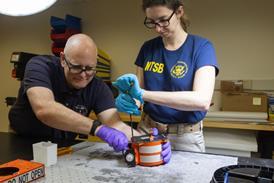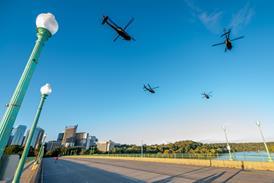The US Air Force could scrap its business jet strategy in favor of an alternative platform for its Joint Surveillance Target Attack Radar System (JSTARS) recapitalisation, according to a recent letter sent from Congressional members to the US defense secretary.
Rather than continue its JSTARS recapitalisation programme, the USAF’s protracted effort to replace its legacy Northrop Grumman E-8C fleet, the service is exploring alternative intelligence and surveillance platforms, according to an 8 September letter sent to Defense Secretary James Mattis. The programme has progressed in fits and starts, hemorrhaging $2 billion when it was halted in 2008.
“We are tremendously concerned about the possibility of any capability gap,” lawmakers wrote Mattis. “While the rationale for this decision has not been made known to us, cancelling or delaying would be ill-advised and directly impact our combatant commanders who employ this asset in theater.”
Lawmakers also learned that the USAF would undertake a new analysis of alternatives for replacing JSTARS, despite at least five previous studies which have examined the recapitalisation. That decision may have been motivated by language in last year's USAF Air Superiority 2030 Flight Plan, which signaled a shift away from business jets to disaggregated systems to satisfy future advanced battle management needs.
“As the Air Force moves forward with the Advanced Battle Management System (ABMS) AOA in 2018, it should include options for non-traditional concepts including networking planned and purpose-built sensors into architectures that enable [battle management command and control] functions in the highly contested environment,” the flight plan states.
The USAF intends to continue source selection for a follow-on JSTARS aircraft while evaluating alternative approaches, the service says in a 12 September statement. Meanwhile, the service will continue flying the legacy fleet through 2023. Last March, a fuselage fatigue study indicated some aircraft could fly through 2034.
“Although we are exploring options, there are many steps still to be taken before any force structure proposals are included in the FY 2019 budget,” the USAF states.
The recent letter comes as Congress prepares to vote on the fiscal year 2018 defense authorization bill, which outlines the Defense Department’s policy and budget. The JSTARS recapitalisation is scheduled to reach initial operational capability by 2024, and the USAF was expected to award a contract in fiscal year 2018.
This week, Senators Johnny Isakson and David Perdue of Georgia, which includes the USAF’s only active duty JSTARS operational squadrons at Robins Air Force Base, introduced an amendment to the National Defense Authorization bill which would prohibit the use of FY18 funds for JSTARS retirement. The amendment would also guarantee the recapitalisation continues unless the defense secretary ensures that the new approach would not result in a BMC2 and ISR capability gap.
Source: FlightGlobal.com























